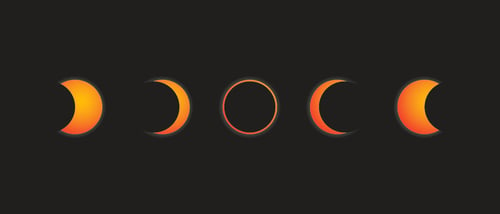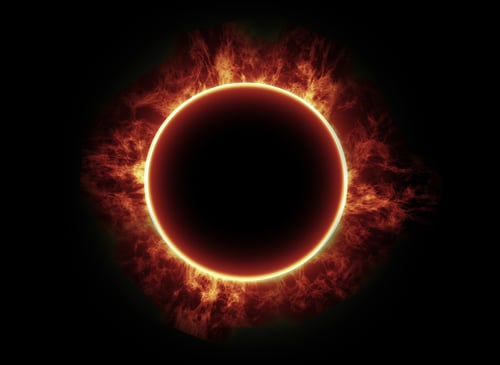Hey there, sky gazers! It’s time to get ready for what’s on the horizon: one of the few solar eclipses we’ll experience in the United States this century! A solar eclipse occurs when the moon passes between the Earth and the sun, casting an enormous shadow on our planet.
Solar eclipses have occurred as long as the Moon has existed and different human cultures throughout time have had different interpretations of and explanations for this phenomenon. The first recording of a solar eclipse may have been from 3340 B.C.E. in what is now Ireland. The site has petroglyphs depicting overlapping, concentric circles that may symbolize changes in the appearance of the sun and moon. There are many petroglyphs in North and Central America made by early indigenous peoples depicting both solar and lunar eclipses, such as the July 1097 solar eclipse at Chaco Canyon, New Mexico. At Mesa Verde, which is in the path of this week’s eclipse, ancient Puebloans built the Sun Temple to observe significant solar and lunar events, and this location in particular is expected to be a hotspot for observers.

The sequence of the moon as it crosses over the sun during an annular solar eclipse.
So, why is next Saturday’s eclipse special? It is an annular solar eclipse, meaning that since the moon is at its farthest distance from the Earth in its orbit, it appears smaller to us, and it doesn’t completely block out the sun. What we’ll experience at its maximum is called the “ring of fire” with the orange-red glow of the sun peaking out, either ominous or reassuring, however you personally view it.
While solar eclipses only occur two to five times per year on the entire planet, we’ll actually get a total solar eclipse that crosses the eastern United States in just six months, on April 8, 2024. During a total solar eclipse, the sky will go completely dark, and we Earthlings can see the corona of the sun which is normally impossible to see by the naked eye. There will only be ten solar eclipses to grace the United States this entire century.

The sun appears as a ring of fire when under the direct shadow of the annular solar eclipse.
This week, the best seats in the house are probably Antarctica, where the show begins at 1:48 a.m. MDT Saturday morning. Can’t get yourself to this exclusive location? The shadow kisses Oregon at 10:13 a.m. MDT, then follows a southeasterly path through Nevada, through the Four Corners region, and across Texas. Here in Eagle County, we’ll be at least 240 miles from the closest locations to view the ring of fire. That’s not too far for us to drive, but it may be too late to get a reservation somewhere if you haven’t yet picked your ideal viewing location. If you’re staying put and paying attention around 10:25 a.m., though, you’ll probably notice the color of the sunshine change and the temperature drop as we experience a partial eclipse here in town.
Now, a word of caution: never look directly at the sun without proper eye protection. Even during an eclipse, the sun’s rays can be harmful to your eyes. Make sure you wear certified eclipse glasses or other safe viewing methods like a pinhole projector.
If you’re going to miss the cosmic show this week, it’s not too late to plan for April’s total solar eclipse. Amazingly, more than half of the U.S. population lives within 250 miles of the path of totality. Cities like Dallas, Indianapolis and Cleveland are already bracing for record visitation from people looking to experience this unique, jaw-dropping natural phenomenon. Happy sky watching!
Hannah Rumble is the Community Programs Director at Walking Mountains Science Center and will be observing the solar eclipse with fellow nature nerds from an undisclosed location.







